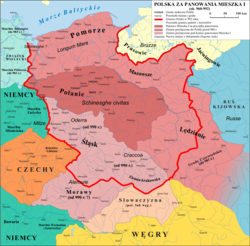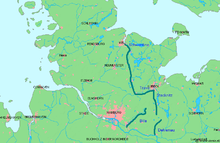Lechites
Lechites (
History


According to Polish legend,
Bolesław I the Brave, founded the bishoprics at Wrocław, Kołobrzeg, and Kraków, and an archbishopric at Gniezno. Bolesław carried out successful wars against Bohemia, Moravia, Kievan Rus' and Lusatia
, and forced the western Pomeranians to pay Poland a tribute. Shortly before his death Bolesław became the first King of Poland in 1025.
Lechitic group
- Poles and Polans
- Masovians
- Vistulans
- Goplans
- Lendians
- Silesian tribes
- Bieżuńczanie
- Bobrzanie
- Dziadoszanie
- Golęszyce
- Lubuszanie
- Opolanie
- Ślężanie
- Trzebowianie
- Pomeranians
- Kashubians
- Slovincians (†)
- Pyrzyczanie(†)
- Wolinianie(†)
- Polabians(†)
- Radimichs[4] (†)
- Vyatichi[4] (†)
- Obodrites/Abodrites (†)
- Obotrites proper
- Wagrians
- Warnower
- Polabians proper
- Linonen
- Wenden
- Sorbs
- Venedi
- Luzyczanie
- Veleti (Wilzi) (†)
- Lutici (Liutici)
- Kissini(Kessiner, Chizzinen, Kyzziner)
- Circipani(Zirzipanen)
- Tollensians
- Redarians
- Ucri(Ukr(an)i, Ukranen)
- Rani (Rujani)
- Hevelli (Stodorani)
- Volinians(Velunzani)
- Pyritzans(Prissani)
- Lutici (Liutici)
Lechitic languages
The
Polabians. The northern so-called Lechitic group includes, along with Polish, endangered Pomeranian and Polabian, a dead language; Silesian, which is variously considered a Polish dialect or a language in its own right, is also part of this group. The Sorbian languages of the southern part of the Polabian area, preserved as relics today in Upper and Lower Lusatia, occupy a place between the Lechitic and Czech-Slovak groups.[5]
The name Lech
Chronica Polonorum by chronicler Maciej Miechowita
(Matthias de Miechow)The name
. The oldest part ofGreat Poland
, is known as Wzgórze Lecha ("Lech's Hill") as well as Góra Królewska ("Royal Hill").
Res gestae saxonicae sive annalium libri tres chronicle of 10th-century Germany, written by Widukind of Corvey, noted that Mieszko I (son of Siemomysł and grandchild of Lestek), ruled over the tribe called the Licicaviki,[9] who lived in what is now Poland and were known as "Lestkowici" - the tribe of Lestek identified by the historians with the Lendians
.
Ottoman Turkish
).
Legends
In Polish literature
Lechia), Bohemia (Čechy, now known as the Czech Republic), and Rus (Ruthenia). In this legend Lech was the founder of Gniezno
.
Three brothers Lech, Czech and Rus were exploring the wilderness to find a place to settle. Suddenly they saw a hill with an old oak and an eagle on top. Lech said: this white eagle I will adopt as an emblem of my people, and around this oak I will build my stronghold, and because of the eagle nest (Polish: gniazdo) I will call it Gniezdno (modern:
Rus').[12]
A variant of this legend, involving only two brothers Lech and Čech, was first written down by Cosmas of Prague of Bohemia. The legend was described by Kronika wielkopolska ("Greater Poland Chronicle"),[14] written in 1273 in Latin, and Chronicle of Dalimil, written in Czech in 1314.[15]
See also
Wikimedia Commons has media related to Lechites.
Look up lechites in Wiktionary, the free dictionary.
- Lech (disambiguation)
- Lechia
- Lendians
- Polish tribes
- Sorbian people
- Lechitic languages
References
- ^ Tadeusz Lehr-Spławiński. Język polski. 1978
- Western Slavs" (ef. Old Rus'ian ljaxy) [in:] Omeljan Pritsak. Old Scandinavian sources other than the sagas. 1981. p. 300
- ^ "Vandalis, Gothis, Longobardis, Rugis et Gepidis, quos vacant aliqui Cimbros, quos hodie vocamus Pomeranos" [in:] Jan Długosz. Annales seu cronicae incliti Regni Poloniae. t. I., p. 35
- ^ a b Henryk Paszkiewicz. The making of the Russian nation. Greenwood Press. 1977. p. 353.
- ^ Bohemia and Poland. Chapter 20.pp 512-513. [in:] Timothy Reuter. The New Cambridge Medieval History: c. 900-c.1024. 2000
- ^ Knoll & Schaer (eds.), Gesta Principum Polonorum: The Deeds of the Princes of the Poles, (Budapest, 2003
- ^ Ljudmila Mikhailovna Popova (ed.), Gall Anonim, Khronika u Deianiia Kniazei ili Pravitelei Polskikh, (Moscow, 1961
- ^ Laurence Mizler de Kolof (ed.), Historiarum Poloniae et Magni Ducatus Lithuaniae Scriptorum Quotquot Ab Initio Reipublicae Polonae Ad Nostra Usque Temporar Extant Omnium Collectio Magna, (Warsaw, 1769
- ^ Wood, Raymond F. (tr.). "The three books of the deeds of the Saxons, by Widukind of Corvey, translated with introduction, notes, and bibliography." Dissertation. University of California, Los Angeles, 1949. English translation
- ^ "Text of "Chronica seu originale regum et principum Poloniae" in Latin". Archived from the original on 2021-07-12. Retrieved 2011-01-04.
- ^ "Monumenta Poloniae historica" T. 2 red. August Bielowski, Lwów 1872
- ^ ISBN 978-83-242-1275-0
- ISBN 978-0-8014-3694-9p. 471
- ^ Brygida Kürbisówna, "Studia nad Kroniką wielkopolską", Poznańskie Towarzystwo Przyjaciół Nauk, Poznań 1952
- ^ Die alttschechische Reimchronik des sogenannten Dalimil, Munich: Sagner, 1981
